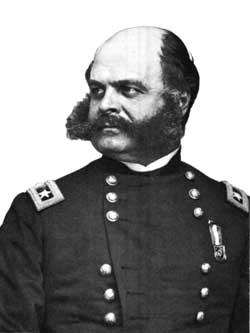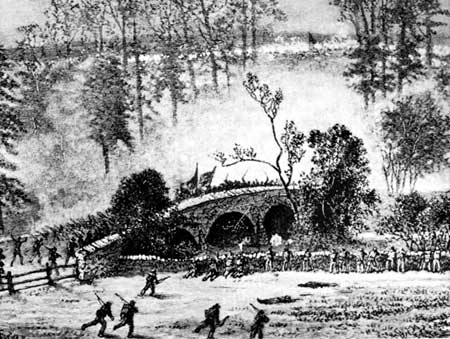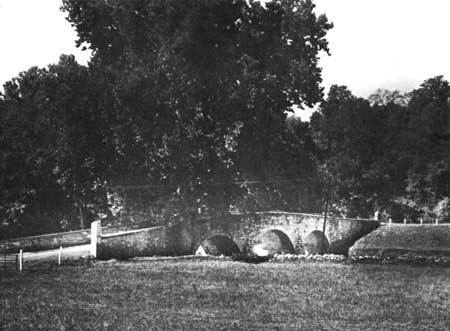|
ANTIETAM National Military Site |
 |

Burnside or Lower Bridge shortly after the battle. Toombs' men
were on the bluff in background.
Courtesy, Library of
Congress.
Burnside Takes the Lower Bridge
During the morning of the 17th, Confederate observers on the ridge north of Sharpsburg had spotted masses of Federals moving southward beyond Antietam Creek. These were the four divisions of Burnside's IX Corps concentrating for the attack on the Lower Bridge.
Topography at the Lower Bridge heavily favored the few hundred Georgia men who defended it under the leadership of Brig. Gen. Robert Toombs. The road approaching the east end of the bridge swings on a course paralleling that of Antietam Creek; in the last few hundred yards before reaching the bridge, the road plunges into a funnel-like depression between the opposing bluffs of the creek. Toombs' men were in rifle pits on the west bluff overlooking the bridge and the approach road.
Because of faulty reconnaissance, Burnside did not know that fords were nearby where his men could have waded across the stream. Instead, the Federal plan of attack forced the advancing columns to pile into this funnel and storm across the bridge.

Maj. Gen. Ambrose E. Burnside.
From photograph by Brady or
assistant. Courtesy, Library of Congress.
Soon after 9 a.m., the Federal divisions began to assault the bridge. One after another, their gallant charges were broken by deadly short-range fire from Toombs' Georgians. By noon, when the agony at the Sunken Road was reaching its highest pitch, and despite repeated orders from McClellan to get across Antietam Creek at all costs, the bottleneck at the bridge was still unbroken.
Meanwhile, Brig. Gen. Isaac Rodman's Union division had moved slowly downstream from the bridge in search of a crossing. Rounding a sharp bend in the creek, nearly a mile south, scouts came upon shallow water at Snavely's Ford. Late in the morning Rodman crossed the stream and began to drive against the right flank of the Georgians guarding the bridge. About the same time, Col. George Crook's scouts located a ford a few hundred yards above the bridge; there he sent his brigade across. Capt. Seth J. Simonds' battery was placed in position to command the bridge.


Burnside's men storm the bridge (top).
From wartime sketch by
Forbes.
The same view today (bottom). Note how tree at near end of bridge has grown.
At 1 p.m., the defending Confederates saw a sudden stir across Antietam Creek. Two regiments, the 51st New York and the 51st Pennsylvania, marched swiftly out from the cover of the wooded hill and charged for the bridge. Supported now by converging artillery fire, they quickly formed into columns and were over the bridge before Confederate artillery could halt them. Soon a wide gap split the Confederate defense. Masses of Federal troops poured across the bridge while Rodman and Crook hammered the Confederate flanks. Burnside's men had gained the west bank of the creek.
But again there was fateful delay as Burnside paused to reorganize. By the time he was ready to drive the Southern defenders from the ridge in his front, 2 critical hours had passed.
Close to 3 p.m., the mighty Federal line moved slowly up the hill toward Sharpsburg, then gained momentum. "The movement of the dark column," related an observer, "with arms and banners glittering in the sun, following the double line of skirmishers, dashing forward at a trot, loading and firing alternately as they moved, was one of the most brilliant and exciting exhibitions of the day."

Zouaves of Burnside's IX Corps charge toward
Sharpsburg.
From wartime sketch by Forbes. Courtesy, Library of
Congress.
First brushing aside the depleted ranks in the rifle pits above the bridge, the Federals struck D. R. Jones' four lonely brigades on the hills southeast of Sharpsburg—whence every other Confederate infantry unit had been withdrawn to reinforce the line to the north. Unable to stem the massive Federal attack, Jones' men were driven back toward the town.
To halt the Federal tide, Lee shifted all available artillery south ward. By 4 p.m., however, the Federals were approaching the village itself; only a half mile lay between them and Lee's line of retreat to the Potomac. Disaster seemed at hand for Lee's decimated force.

|

|
|
Last Modified: Mon, Mar 4 2002 10:00:00 pm PDT |


